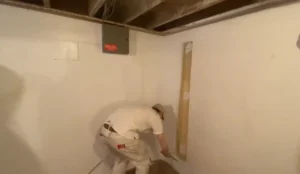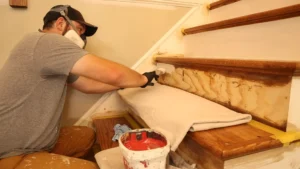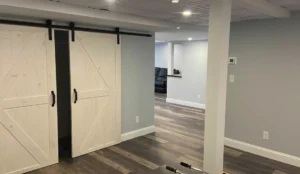Waterproofing a basement in 2024 is an important step for keeping your home safe and dry. On average, people spend about $4,920 on this project. The cost can range from $3,000 to $10,000 for spaces as big as 1,000 square feet.
Costs per square foot vary too. Damp proofing might cost you between $3 and $6 while full waterproofing could set you back between $5 and $10 per square foot. In places like Michigan, the price for sealants and coverings falls between $1 to $3 due to its location.
If your foundation has cracks that need fixing, plan on spending an extra $250 to $800. Sometimes water damage or mold pops up during the process; these added services will increase what you pay in total.
Adding tools like sump pumps also affects your budget but keeps water out effectively; these devices alone can range from a low of around three hundred dollars up to four thousand dollars depending on what type you get.
This guide takes a deep look at all factors that shape how much it costs to keep basements dry—from the size of the space and the method chosen for waterproofing true labor costs across different regions down to other needs like fixing damages or getting rid of mold.
You’re ready for more details now!
Key Takeaways
- Waterproofing a basement can average $4,920, but the final price depends on the basement size, the method used, labor costs, where you live, and your foundation’s condition.
- Methods range from interior sealing costing $200 to $3,000 to exterior excavation which could be between $100 to $290 per linear foot. Choosing DIY or professional help impacts cost as well.
- Upgrading gutters and installing sump pumps are effective ways to prevent water damage at a lower cost compared to full waterproofing projects.
- Finishing or remodeling your basement not only adds living space but also requires considering moisture barriers and adequate insulation for dryness and comfort.
- Hiring experienced professionals for basement waterproofing can save money in the long run by avoiding mistakes and ensuring lasting protection against water damage.
Factors Affecting Basement Waterproofing Costs
Factors impacting the cost of basement waterproofing include the size of the basement, chosen waterproofing method, labor expenses, location, condition of the foundation, and any additional services needed.
These factors can influence the overall cost significantly.
Basement Size
The size of your basement plays a significant role in determining the cost of waterproofing it. From personal experience, a smaller basement will naturally cost less to waterproof than a large one.
The price can vary greatly depending on whether you’re dealing with a cozy space or an expansive area meant for storage or living. Calculations often get made on a per-square-foot basis, ranging from $5 to $10.
This method helps homeowners understand the direct relationship between the area of their basements and the total cost.
Next, consider which waterproofing method will best suit your needs and budget.
Waterproofing Method
After considering the size of your basement, selecting the right waterproofing approach is crucial. Different methods range in complexity and cost. For internal waterproofing, techniques include sealing cracks with water-resistant materials or applying a vapor barrier to prevent moisture entry.
This might cost between $50 to $100 for every linear foot covered. On the other hand, external waterproofing involves more extensive work like excavating around your home to install a drainage system or a moisture block layer on exterior foundation walls.
Costs for these services can run from $150 to $250 per linear foot.
Choosing between interior and exterior solutions depends on specific problems your basement faces, such as high humidity levels or water seeping in from the outside. Tools like sump pumps and dehumidifier units play vital roles in managing basement dampness efficiently when combined with these methods.
Each option aims at not only keeping your space dry but also enhancing its longevity by guarding against mold growth and foundation damage due to prolonged exposure to moisture.
Labor
Labor costs for waterproofing a basement vary widely and depend on the chosen method. Interior work might cost between $50 to $100 per linear foot, making it a more affordable option for many homeowners.
This involves activities inside your home, like applying sealants or installing drains that catch water before it can cause damage.
Exterior work is more involved and therefore pricier, ranging from $150 to $250 per linear foot. This type of labor often requires heavy digging around the home’s foundation and putting in barriers, like bentonite clay or waterproof membranes, to block moisture from getting in.
These rates reflect the need for special equipment and skills to ensure your basement stays dry and safe.
Geographic Location
Geographic location significantly impacts the cost of basement waterproofing. In regions with high moisture levels or frequent rainfall, such as the Pacific Northwest or Southeast, the need for extensive waterproofing may drive up costs.
Conversely, drier areas like Arizona or Nevada may entail lower expenses due to reduced moisture infiltration. Additionally, coastal areas are prone to flooding and might require specialized waterproofing solutions involving higher costs.
The geographic location plays a pivotal role in determining the overall cost of basement waterproofing due to varying environmental conditions and water table levels across different regions.
Foundation Condition
The condition of your foundation plays a crucial role in determining the cost of basement waterproofing. Minor cracks or damages can often be repaired at a relatively low cost, ranging from $250 to $800.
However, extensive structural issues may require more intricate and expensive repairs. Factors such as the presence of efflorescence, french drain systems, and weeping tiles can also affect both the method and expense required for waterproofing.
Understanding your foundation’s condition is essential to accurately assess the scope of work needed and determine an appropriate budget for potential repairs and waterproofing solutions.
Additional Services (mold remediation, water damage repair)
Mold remediation and water damage repair are critical services that may accompany basement waterproofing. Addressing mold growth and addressing any existing water damage not only ensures a healthier indoor environment but also prevents future structural issues.
Mold remediation involves identifying, containing, and removing mold to prevent its spread and recurrence. On the other hand, water damage repair focuses on restoring affected areas to their pre-damaged state.
Both services require specialized equipment and expertise to effectively mitigate potential hazards associated with damp environments.
Types of Basement Waterproofing Methods
Basement waterproofing methods include interior and exterior sealing, as well as the option of DIY versus professional services. Interior sealing involves applying waterproof paint or cementitious coating to the interior walls to prevent moisture penetration.
On the other hand, exterior sealing entails using techniques such as epoxy injection or installing an exterior french drain to keep water out from the outside.
Interior Sealing
Interior sealing, which involves applying sealants to the interior walls and floors of a basement, is a cost-effective method for preventing moisture infiltration. Typical costs for interior basement sealing range from $200 to $3,000.
The price per linear foot can vary between $50 and $100, while the cost of internal sealants typically ranges from $3 to $7 per square foot. This method creates an impermeable barrier that prevents water from seeping through the foundation, significantly reducing the risk of mold growth and water damage.
Focusing on practical guidance for homeowners seeking to upgrade their basements, individuals should consider incorporating interior sealing as part of their waterproofing strategy.
Exterior Sealing
Exterior sealing, also known as external waterproofing, is a method used to prevent water from infiltrating the basement through the foundation walls. This process entails excavating around the exterior of the house down to the foundation footing, applying a waterproof coating or membrane to the wall’s surface, and installing new drainage systems such as weeping tiles or French drains.
The average cost for this method in Toronto ranges between $100 and $290 per linear foot, with variations due to factors like location and size. It is essential to consider hiring a professional for this task due to its labor-intensive nature.
External waterproofing keeps moisture at bay by providing a durable barrier against water intrusion, helping homeowners avoid potential damage caused by leaks or flooding. Additionally, improving yard grading and ensuring proper gutter installation can complement exterior sealing efforts in preventing water accumulation around the foundation area.
DIY vs. Professional Waterproofing
Transitioning from considering the options of exterior sealing, it’s essential to weigh the pros and cons of DIY versus professional waterproofing for basements. Both approaches offer distinct advantages based on your specific circumstances.
Opting for a do-it-yourself approach can often be cost-effective, especially if you are experienced in home improvement projects. It allows you to customize the solution tailored to your basement’s needs as well as save on labor costs.
On the other hand, professional waterproofing ensures meticulous application of industry-grade methods and materials, potentially providing long-term peace of mind while adding value to your property.
How to Save Money on Basement Waterproofing Costs
Upgrade your gutters to direct water away from the foundation, install a sump pump to prevent standing water, and consider hiring a professional for expert advice. Click here for more cost-saving tips.
Upgrading gutters
Upgrading your gutters can significantly reduce the risk of water seeping into your basement, ultimately saving you money on costly waterproofing. Properly functioning gutters aid in redirecting rainwater away from your foundation, preventing potential water damage in the basement.
Quality gutters and regular maintenance contribute to a proactive approach in protecting your basement from any water-related issues. Investing in good gutters is not only cost-effective but also savvier than dealing with major repairs later on.
Properly installed and well-maintained gutters play a crucial role in keeping your basement dry and minimizing water infiltration risks. Taking this preventive step eliminates the need for expensive waterproofing measures, making it an essential aspect of maintaining a dry and secure basement environment.
Installing a sump pump
Once gutters are upgraded to efficiently manage water flow, the next critical step in basement waterproofing is installing a sump pump. The cost varies based on factors such as whether your home already has a sump basin and can range from $300–$4,000 for labor and materials.
Homeowners should anticipate an additional investment of $3 to $10 per square foot for total encapsulation. Professional installation ensures robust protection against moisture intrusion by managing groundwater effectively.
To combat dampness effectively, homeowners can consider DIY options supported by proper research or invest in professional service providers equipped with the expertise and tools required for precise system installation.
Finishing/remodeling the basement
To create a functional living space, consider finishing or remodeling your basement. The average cost to finish a basement ranges from $7 to $23 per square foot, while a full remodel can cost between $30 to $75 per square foot.
Factors such as the level of finishing and size of the project influence overall costs. It’s crucial to assess the specific needs of your household before embarking on this renovation, considering factors like adequate insulation, moisture barriers, and HVAC system requirements for an energy-efficient and comfortable living area.
When embracing this project, it is important to carefully plan for proper drainage solutions if needed. Additionally, addressing any foundational issues during this process ensures long-term stability and prevents future complications.
This essential upgrade not only adds value but also contributes positively to the indoor air quality of your home.
Hiring a professional
When hiring a professional for basement waterproofing, it’s crucial to choose an experienced and reputable contractor. A skilled professional can accurately assess the specific needs of your basement, recommend the most effective waterproofing method, and ensure the job is done efficiently.
By entrusting this task to a professional with expertise in basement waterproofing, you can save money in the long run by avoiding costly mistakes or recurring issues.
To minimize potential risks and achieve optimal results for your basement waterproofing project, seeking guidance from a knowledgeable professional offers peace of mind knowing that the job will be carried out effectively.
It also ensures that your investment in basement waterproofing yields lasting benefits for your home.
Is Basement Waterproofing Worth the Cost??
Basement waterproofing ensures protection against water damage and mold, enhancing the structural integrity of your home. The long-term benefits outweigh the initial investment, safeguarding your property and reducing potential repair costs.
Opting for basement waterproofing not only secures your home but also promotes a healthier living environment by preventing mold growth and preserving indoor air quality.
Benefits of basement waterproofing
Waterproofing your basement offers several advantages. Firstly, it prevents water damage and mold growth. This safeguards your property’s structural integrity and enhances indoor air quality.
In addition, basement waterproofing creates a drier and healthier living environment for you and your family. Moreover, it can increase the usable space in your home by transforming damp basements into functional areas such as recreation rooms or additional bedrooms.
Basement waterproofing also contributes to long-term cost savings by preventing expensive water-related repairs or remediation services. Additionally, it adds value to your property while potentially lowering insurance premiums due to reduced risk of flooding or water damage claims.
Factors to consider
When considering waterproofing your basement, it’s essential to account for the size of your basement, as larger spaces typically require more materials and labor. The condition of your foundation is also crucial as any existing damage may need addressing before waterproofing can commence.
Additionally, the type of waterproofing method you choose will impact costs significantly. Your geographic location plays a significant role too since different regions have varying levels of moisture and soil conditions, affecting the complexity and cost of the project.
Keep in mind that factors such as additional services like mold remediation or water damage repair can add to the overall expense. It’s advisable to thoroughly assess these considerations before making any decisions about waterproofing your basement.
Long-term savings
Long-term savings from basement waterproofing can be significant, potentially outweighing the initial investment. With an average cost of $4,920 for waterproofing a basement and potential long-term savings in avoidance of water damage repair costs ranging from $2,300 to $7,575, homeowners could safeguard against structural damage and mold remediation expenses.
The national average cost to waterproof a basement falls between $5 and $10 per square foot on average, showing the potential for substantial long-term savings by preventing future costly water-related repairs.
This demonstrates that while there is an initial cost involved with basement waterproofing, the long-term benefits in terms of financial outlay are considerable.
Conclusion
Waterproofing a basement in 2024 can incur an average cost of $4,920. The factors impacting the cost include the size of the basement, the chosen waterproofing method, labor expenses, geographic location, and the condition of the foundation.
By considering practical steps to save money on waterproofing costs, such as upgrading gutters and installing a sump pump, individuals can reduce their overall expenses while safeguarding their basements from potential water damage.
It’s essential for homeowners to weigh these costs against the benefits of basement waterproofing and consider long-term savings when making this investment.
FAQs
1. What does it mean to waterproof a basement?
Waterproofing a basement means taking steps to prevent water from entering the space. This can include interior and exterior methods like applying sealants, installing drains such as window well drains or sump pumps, and fixing foundations.
2. How much can I expect to pay for interior waterproofing in 2024?
The cost of interior waterproofing varies based on the method used, but common options like sump pump installation or an interior French drain system could range from a few hundred to several thousand dollars.
3. Is exterior waterproofing more expensive than interior?
Yes, generally, exterior waterproofing costs more because it often involves more complex procedures like digging trenches around the foundation or applying asphalt or sodium bentonite outside the walls. Prices can significantly vary depending on your home’s size and specific needs.
4. Will adding vapor barriers in my crawl space help with dampness?
Vapor barriers are effective at controlling moisture in crawl spaces by preventing water vapor from seeping through floors and walls. Installing them is a proactive step towards keeping your basement dry.
5. Can mold removal be part of the basement waterproofing process?
Absolutely! If your basement has been flooded or saturated with water before, there might be mold growth. Mold removal is crucial for maintaining healthy air quality and should be addressed during the waterproofing process.
6. Does homeowners insurance cover basement waterproofing costs?
Typically, homeowners insurance does not cover costs for preventive measures like basement waterproofing unless specified otherwise in your policy terms regarding damage repair after floods or similar events.






